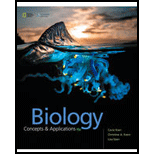
Concept explainers
Introduction:
Every organisms present in the environment contains cell. The cell is the basic “fundamental unit” of life. Cell performs a number of important functions. These are termed as cellular activities. Reproduction is also an important cellular activity. All the new cells are formed from the old cell. The process by which a cell produces its progenies is termed as reproduction.
Answer to Problem 1SA
Correct answer:
The single-celled prokaryotes reproduce asexually by mitosis and cytoplasmic division. Hence, the correct answer is option a.
Explanation of Solution
Reason for correct answer:
Option a. is given as “asexual reproduction of single-celled prokaryotes”.
The prokaryotes are simple organisms that lack a well-defined nucleus. The genetic material in prokaryotes lies freely in the cytoplasm. The unicellular prokaryotes reproduce asexually through mitosis and cytoplasmic division. Mitosis is a process in which the nucleus of the cell divides. Mitosis has the capability to maintain the number of chromosomes present inside the nucleus. The cytoplasmic division is the process in which the cytoplasm of the parental cell divides into two equal parts. These two parts are termed as daughter cells.
Reason for incorrect answer:
Option b. is given as, “development and tissue repair in multicelled species”.
Mitosis and cytoplasmic division are the methods of asexual reproduction. Mitosis is also involved in the development and tissue repair mechanisms in some multicellular organisms. However, the cytoplasmic division has no role in the development and tissue repair mechanism. Hence, option b. is incorrect.
Option c. is given as, “sexual reproduction in plants and animals”.
Mitosis and cytoplasmic division are the two ways of asexual reproduction. This indicates that mitosis and cytoplasmic division are not the methods of sexual reproduction. Hence, option c. is incorrect.
Hence, the options b., and c. are incorrect.
Mitosis and the cytoplasmic division are the two ways in which a unicellular prokaryote reproduces asexually. Thus, the correct option is a.
Want to see more full solutions like this?
Chapter 11 Solutions
BIOLOGY:CONCEPTS+APPL.(LOOSELEAF)
- One of the following is not a function of ordinary cell division produces two daughter cells that are genetically identical Select one: a. Asexual reproduction of an organism b. Cell replacement c. Sexual reproduction d. Growth of an organismarrow_forwardWhich eukaryotic cell-cycle event is missing in binary fission? a. cell growth b. DNA duplication c. mitosis d. cytokinesisarrow_forwardMitosis and cytoplasmic division function in .a. asexual reproduction of single-celled prokaryotesb. development and tissue repair in multicelledspeciesc. sexual reproduction in plants and animalsarrow_forward
- A cell described as n + n is (a) monokaryotic (b) diploid (c) haploid (d)coenocytic (e) dikaryoticarrow_forwardWhich eukaryotic cell-cycle event is missing in binary fission? a. cell growth b. DNA duplication c. karyokinesis d. cytokinesisarrow_forwardIn unicellular organisms, mitosis helps in asexual reproduction as it produces an identical copy of the parent cell. Which of the following organisms reproduce through mitosis? A. Bacteria B. Frog C. Hydra D. Sea anemones Which of the following does NOT signifies the application of mitosis? A. Production of sperms and eggs. B. An amoeba reproduces through binary fission while hydra and yeast reproduce through budding. C. You become taller because the bone cells continue to undergo mitosis D. All the daughter cells resulting from the multiple cell divisions will make up the body of the human. Dolly is the first mammal to have been successfully cloned from an adult cell Which of the following statement/s is/are most relevant to the birth of Dolly? I. It suggests that human could be cloned. II. It proves that specialized cells could be used to create an exact copy of the animal they came from. III. It improves the production of milk, meat, and other products from livestock. IV. It…arrow_forward
- What critical event occurs during the S phase of the eukaryoticcell cycle?a. Cells make a decision of whether or not to divide.b. DNA replication produces pairs of sister chromatids.c. The chromosomes condense.d. The single nucleus is divided into two nucleiarrow_forwardThe type of cell division that is responsible for cell division in amoebas, or other single-celled organisms, is calleda. binary fission.b. DNA replication.c. mitosis.d. apoptosis.arrow_forwardMost eukaryotic organisms are the product of A- asexual reproduction B- sexual reproductionarrow_forward
- Sexual reproduction involves an organism (A.) growing from body parts that are cut or broken off the parent. (B.) being produced through a unique combination of DNA from two gametes. (C.) generating an identical offspring on the surface of its own body. (D.) replicating its DNA before dividing in half to produce two organisms.arrow_forwardIn humans, sexual reproduction that produces an embryo, which then develops into a fetus, requires: a. Neither mitosis or meiosis b. Mitosis c. Both mitosis and meiosisarrow_forwardA common feature of reproduction in Amoeba, spirogyra and yeast is that –a) They reproduce only sexuallyb) They are all unicellularc) they reproduce asexually d) They are all multicellulararrow_forward
 Biology Today and Tomorrow without Physiology (Mi...BiologyISBN:9781305117396Author:Cecie Starr, Christine Evers, Lisa StarrPublisher:Cengage Learning
Biology Today and Tomorrow without Physiology (Mi...BiologyISBN:9781305117396Author:Cecie Starr, Christine Evers, Lisa StarrPublisher:Cengage Learning
 Concepts of BiologyBiologyISBN:9781938168116Author:Samantha Fowler, Rebecca Roush, James WisePublisher:OpenStax College
Concepts of BiologyBiologyISBN:9781938168116Author:Samantha Fowler, Rebecca Roush, James WisePublisher:OpenStax College Biology: The Dynamic Science (MindTap Course List)BiologyISBN:9781305389892Author:Peter J. Russell, Paul E. Hertz, Beverly McMillanPublisher:Cengage Learning
Biology: The Dynamic Science (MindTap Course List)BiologyISBN:9781305389892Author:Peter J. Russell, Paul E. Hertz, Beverly McMillanPublisher:Cengage Learning



